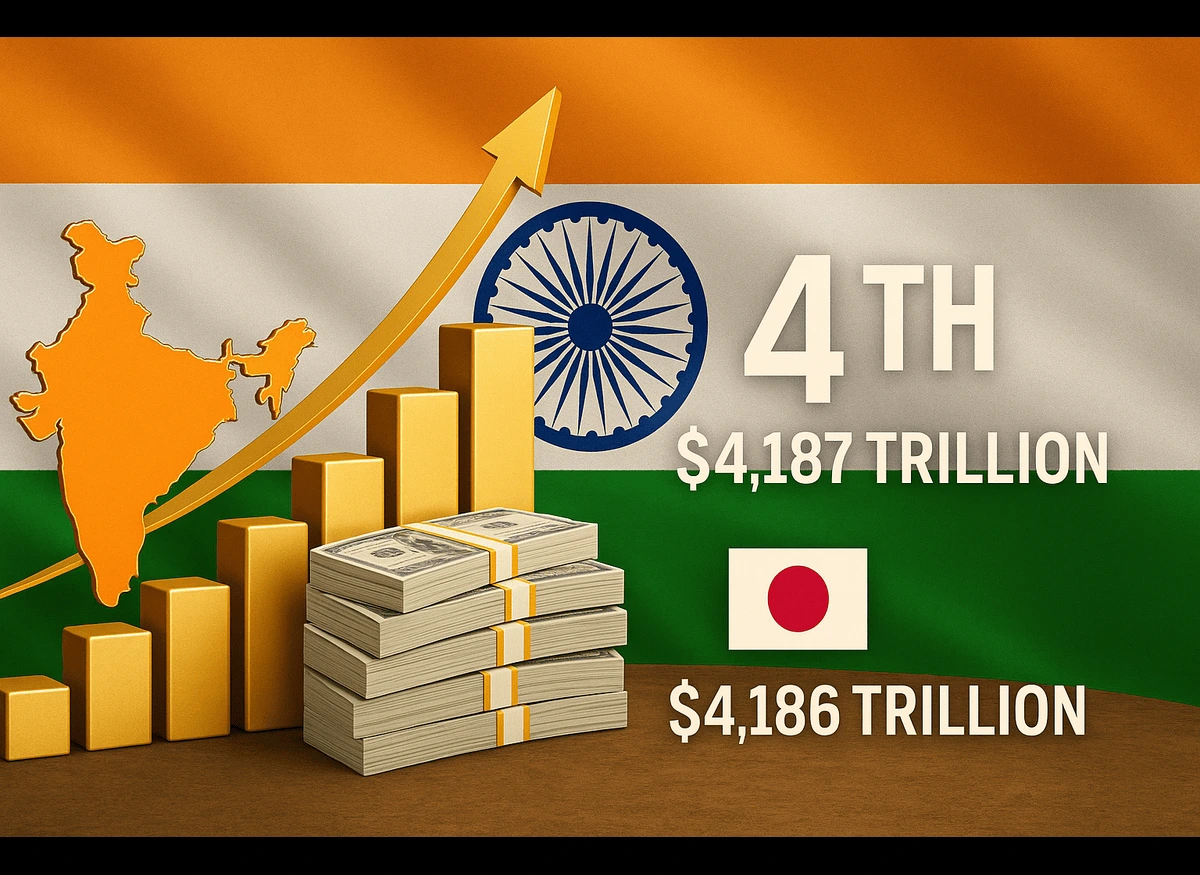
India has overtaken Japan to become the world’s 4th-largest economy with a $4.187 trillion GDP in 2025, signaling a major global power shift. Discover the growth drivers, challenges, and what’s next for India’s economic rise.
India’s ascent to the world’s fourth-largest economy, overtaking Japan in 2025, marks a pivotal moment in the global economic landscape. With a nominal GDP of $4.187 trillion, India has edged past Japan’s $4.186 trillion, according to the International Monetary Fund’s (IMF) April 2025 World Economic Outlook, trailing only the United States ($30.51 trillion), China ($19.23 trillion), and Germany ($4.74 trillion).
This milestone is not just a numerical triumph but a strategic inflection point, signaling Asia’s shifting power dynamics and India’s growing influence in a multipolar world. As global supply chains realign and post-pandemic recovery reshapes capital flows, India’s rise underscores its resilience and ambition. This article explores the catalysts behind this surge, the challenges that remain, and what lies ahead for India’s economic trajectory.
The Numbers Behind India’s Economic Leap
India’s GDP growth has been remarkable, with a compound annual growth rate (CAGR) of approximately 8% over the past five years, outpacing major economies like the United States (2.8%), China (4.8%), and Japan (0.3%) in 2024. In 2023, India’s GDP stood at $3.55 trillion, trailing Japan’s $4.22 trillion, but by 2025, India closed the gap, driven by robust domestic consumption and structural reforms. The IMF projects India’s real GDP growth at 6.2% for 2025, making it the fastest-growing major economy.
India now contributes significantly to global GDP growth, accounting for roughly 15% of the world’s economic expansion, a stark contrast to Japan’s stagnation amid an aging population and deflationary pressures. Currency dynamics, including a weakened Japanese yen, have also tilted the scales in India’s favor.

Five Pillars of India’s Economic Surge
India’s climb to the fourth spot is no accident—it’s the result of deliberate structural reforms and strategic initiatives:
Digital Public Infrastructure (DPI):
India’s digital backbone, including Aadhaar (1.4 billion unique IDs) and the Unified Payments Interface (UPI, handling 15 billion monthly transactions worth $430 billion in 2025), has revolutionized financial inclusion and economic efficiency. The Open Network for Digital Commerce (ONDC) further democratizes e-commerce, fostering inclusive growth.
Manufacturing Renaissance:
The ‘Make in India’ initiative and Production-Linked Incentive (PLI) schemes have revitalized manufacturing. India now produces 400 million smartphones annually and is the third-largest passenger vehicle market, with electric vehicle (EV) sales growing at an 80% CAGR.
Startup Ecosystem:
With over 100 unicorns and 130,000 startups, India’s innovation hubs are driving sectors like fintech, edtech, and healthtech. Companies like Zomato and Paytm are expanding globally, supported by $20 billion in annual venture capital inflows.
Financial Deepening:
India’s stock market, now the fourth-largest globally at $4.33 trillion, reflects growing investor confidence. Systematic Investment Plan (SIP) inflows have surged, with mutual funds seeing record participation, fueled by digital platforms.
Trade and Investment Diplomacy:
Free Trade Agreements (FTAs) like the UAE–India CEPA and ongoing India–EU talks have boosted foreign direct investment (FDI). In 2024, FDI inflows supported job creation and upskilling, with companies like Deutsche Bank and Merck leveraging India’s business ecosystem.
The Demographic Engine Powering Growth
India’s median age of 29.5, compared to Japan’s 48 and Europe’s 44, is a critical advantage. With 65% of its population under 35, India’s youthful workforce drives productivity and consumption. Urbanization is accelerating, with the middle class projected to grow to 46% of the population by 2030, fueling demand for housing, retail, and services.
The digital economy, powered by a tech-savvy youth, is thriving—creator economy platforms, edtech firms like BYJU’S, and gig jobs are reshaping work. Internet penetration has soared to 65% from 20% in 2010, amplifying economic activity.
Redefining Global Economic Orthodoxy
India’s rise challenges the post-war G7-centric economic order. As a leader in the G20 and BRICS, India’s diplomatic influence is growing, evidenced by its advocacy for the African Union’s G20 membership. The ‘China+1’ strategy has made India a magnet for global firms seeking to diversify supply chains, with companies like Apple and Foxconn expanding operations. India’s $700 billion foreign exchange reserves and stabilized rupee further enhance its resilience against global shocks. This shift signals a multipolar world where India’s voice in Bretton Woods institutions like the IMF and World Bank is increasingly significant.
Challenges Beneath the Triumph
Despite its achievements, India faces critical hurdles:
Structural Unemployment:
Jobless growth persists, with 90% of the workforce in informal jobs and women’s labor force participation at just 26%. India needs 145–330 million new jobs by 2050 to leverage its demographic dividend.
Environmental Trade-Offs:
As the third-largest CO2 emitter, India faces a $2.5 trillion financing gap to meet its net-zero emissions goal by 2070. Extreme climate events threaten 2.5–4.5% of GDP annually by 2030.
Income Inequality:
Rural-urban disparities and uneven access to services remain stark, with per capita GDP at $2,400 compared to Japan’s $33,000.
Health and Education Quality:
Low public spending (3% of GDP on education) and skilling gaps hinder human capital development.
Thought Leadership: Voices Shaping the Narrative
Industrialist Anand Mahindra aptly noted, “This is no small achievement, but it’s also not a finish line.” Economist Raghuram Rajan emphasizes sustainable reforms over short-term growth spurts, warning against complacency. Arvind Subramanian highlights the need for capital formation to rise from 24% to 32% of GDP to sustain 8%+ growth, akin to China’s peak years. NITI Aayog CEO BVR Subrahmanyam sees India’s trajectory as a matter of 2–3 years to claim the third spot, provided reforms continue.
Can India Overtake Germany by 2027?
The IMF projects India’s GDP to reach $5.58 trillion by 2028, potentially surpassing Germany’s $5.25 trillion. To achieve this, India must scale infrastructure (e.g., 10,000 km of high-speed rail), boost R&D spending to 2% of GDP, and enhance regulatory ease. The ‘India @100’ vision aims for a $10 trillion economy by 2035, requiring consistent 8% growth and universal digital literacy. Germany’s projected zero growth in 2025 due to trade tensions gives India a window of opportunity.
India’s Crossroads: From Growth to Global Leadership
India’s ascent to the fourth-largest economy is a historic milestone, but its true test lies in sustaining this momentum. From being the world’s back office, India is now stepping into the global boardroom, wielding economic and geopolitical influence. The question remains: Is India ready not just to grow, but to lead responsibly in a multipolar world? With strategic reforms, inclusive policies, and a focus on sustainability, India can redefine global economic leadership for the 21st century.
Discover more from Poniak Times
Subscribe to get the latest posts sent to your email.







